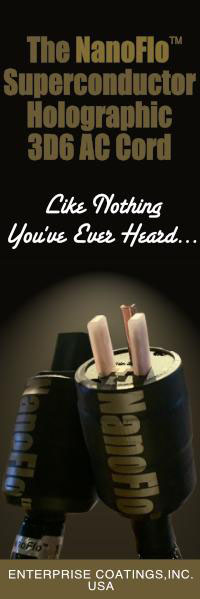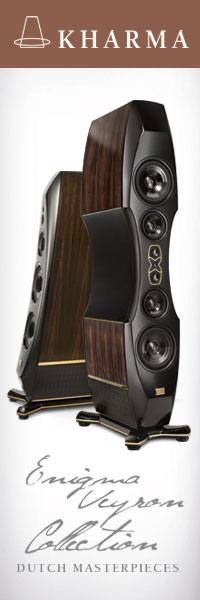Acoustic Revive’s RAS-14 A/C Stabilizer
|
Acoustic Revive’s RAS-14 A/C Stabilizer |
| But should I doubt my ears? |
|
|
|
November, 2010 |

You can’t pee in the same river twice
Fact: the audiophile is a fickle creature. This is especially true if he – it’s almost always a he – has replacement toys to fuss with. True to type, I’ve removed some Acoustic Revive items in and around my sound system and retained others. In the matter of retention, I’m reasonably certain that the two RAS-14 A/C Stabilizers sticking out of my amps’ butts are likely to remain. After a pleasantly brief burn-in, they made a difference I’d hate to relinquish. I intend to put the impression to the test.
Received information
Acoustic Revive’s promotional statement describes the RAS-14 as a non-contact, filter-free device. So it would seem that the power to my amps runs a gamut of materials without coming into contact with it. To be non-specific, the RAS-14’s carbon-fiber cylinder contains a mineral mix the recipe for which AR’s Ken Ishiguro chooses not to divulge. I can tell you that he uses green carborundum, tourmaline and quartz-crystal granules in other audio products. I’m not suggesting that the RAS-14’s formulation repeats or resembles any of this. In fact, I don’t know.

To continue with features, we’re told that one of the IEC connectors is rhodium-plated, the other double-plated silver-rhodium, cryogenically treated, in a top-quality Oyaide fitting. The carbon-fiber cylinder is capped, both ends, with hickory pucks. (Suppressing vibration figures large in Ishiguro’s designs. Thus the use of an inert hardwood.) The RAS-14’s 13-inch length reveals six inches of AR’s top power cord.
Continuing with the promotional statement, the RAS-14 is said to absorb a/c and ground noise by way of its “magnetic-wave absorption material,” which I take to be the cylinder’s mystery mix. (If you shake the thing you’ll hear it. Sounds like coarse sand.) The ground-noise claim prompted me to remove AudioPrism’s diminutive Ground Controls occupying the amps’ RCA inputs. (I use balanced interconnects.) In keeping with what I hear every time I do this, the Ground Controls’ removal affected the image’s lifelike qualities. The RAS-14 does not make redundant the Ground Controls’ contributions, which are far more valuable than the GCs’ size would lead one to believe possible.
Other peripherals relevant to this report include AR’s RR-77 Schumann Resonance Generator atop a book tower in another part of the room and a pair of NuForce Magic Cubes on my speaker cables. The Integris CDP and stacked mono amps sit on two AR underboards consisting of a wood base and lid sandwiching a layer of quartz-crystal granules. I routinely treat CDs to AR’s RD-3 demagnetizer and RIO-5 II’s negative-ion bath. This is a CD-only system. I’ve developed into an avid tweakster who may never catch up with Clement Perry. And I say so with no little bitterness.
The test
It’s not feasible to pull these devices, listen to the system without them, and reinstate them for another listen, no less do it “blind,” in as short a time as a valid a/b comparison requires. We plow ahead in typically subjective fashion, which, I admit, is how I prefer to do these things.
 I limited myself to one test track: The fourth movement, Vivace, of Haydn’s String Quartet, Op. 50, No. 1 (The Aurum Series XXIV, Tacet 185, two CDs, a German label distributed in the US by Spinning Dog Records, email address:here). The six Op. 50 quartets, a.k.a. King of Prussia Quartets, are a delight, but more to our purpose, the productions are first-rate. Nothing is so revealing of subtleties as a well-recorded string quartet.
I limited myself to one test track: The fourth movement, Vivace, of Haydn’s String Quartet, Op. 50, No. 1 (The Aurum Series XXIV, Tacet 185, two CDs, a German label distributed in the US by Spinning Dog Records, email address:here). The six Op. 50 quartets, a.k.a. King of Prussia Quartets, are a delight, but more to our purpose, the productions are first-rate. Nothing is so revealing of subtleties as a well-recorded string quartet.
With the RAS-14 pair removed, the sonic image lost depth, dimension, textural and harmonic largesse. This is not to say that listening to the track absent the Stabilizers proved a disappointment. Had I never heard of these things nor had a chance to use them, I’d have called the sound good. It’s ever a question of experiencing a marked improvement you perhaps had thought unlikely until you hear it.
 For my part, the test was conclusive. I followed the Haydn with a blood-on-the-floor performance, volume set high, of Alfred Schnittke’s Concerto for Piano and Strings, with pianist Viktoria Postnikova, Guennadi Rojdestvenski conducting the London Sinfonietta (Erato CD 2292 47542-2, released in 1992). Arkivmusic.com has copies. Surname notwithstanding, Schnittke was a Russian composer with a temperament easily as dark and ironic as that of Shostakovitch. It takes Russians to do this wrenching music justice. I didn’t feel the need to remove the RAS-14 pair just to make sure. I knew that I was hearing a fine recording significantly enhanced by – it must be admitted – a very expensive tweak.
For my part, the test was conclusive. I followed the Haydn with a blood-on-the-floor performance, volume set high, of Alfred Schnittke’s Concerto for Piano and Strings, with pianist Viktoria Postnikova, Guennadi Rojdestvenski conducting the London Sinfonietta (Erato CD 2292 47542-2, released in 1992). Arkivmusic.com has copies. Surname notwithstanding, Schnittke was a Russian composer with a temperament easily as dark and ironic as that of Shostakovitch. It takes Russians to do this wrenching music justice. I didn’t feel the need to remove the RAS-14 pair just to make sure. I knew that I was hearing a fine recording significantly enhanced by – it must be admitted – a very expensive tweak.
For the big number, see below. I’ve given up commenting on what things cost. Not my place. We’re all grownups. We make our own decisions. The RAS-14 is a well-made piece of equipment that does a bang-up job. That much I can report with confidence.
But should I doubt my ears?
I write this in a state of elation. I’ll come back tomorrow to confirm my opinion in the cold light of day.
OK, it’s tomorrow. Did I exaggerate?
No.

![]()
Acoustic Revive RAS-14 A/C Stabilizer, $1095.
Website: www.acoustic-revive.com
Email: y-hontani@musonpro.com
US Distributor: The Lotus Group.
Website: www.lotusgroupusa.com
Email: info@lotusgroupusa.com
![]()
Don’t forget to bookmark us! (CTRL-SHFT-D)
Stereo Times Masthead
Publisher/Founder
Clement Perry
Editor
Dave Thomas
Senior Editors
Frank Alles, Mike Girardi, Russell Lichter, Terry London, Moreno Mitchell, Paul Szabady, Bill Wells, Mike Wright, and Stephen Yan,
Current Contributors
David Abramson, Tim Barrall, Dave Allison, Ron Cook, Lewis Dardick, John Hoffman, Dan Secula, Don Shaulis, Greg Simmons, Eric Teh, Greg Voth, Richard Willie, Ed Van Winkle, Rob Dockery, Richard Doron, and Daveed Turek
Site Management Clement Perry
Ad Designer: Martin Perry





Be the first to comment on: Acoustic Revive’s RAS-14 A/C Stabilizer